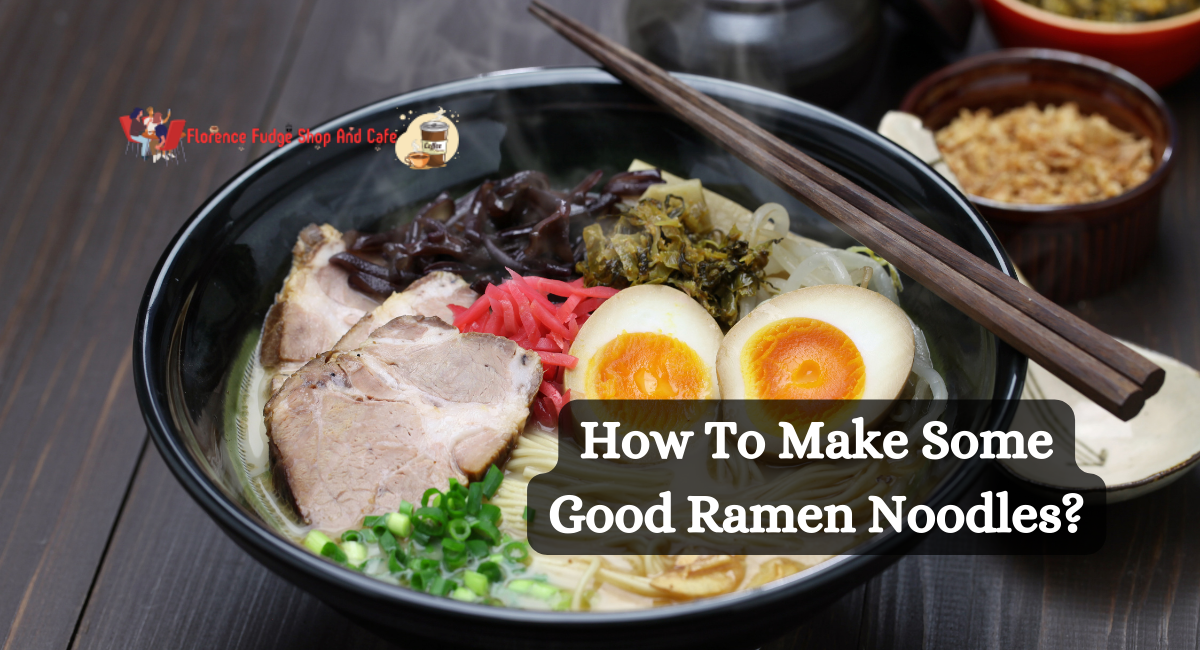Ramen noodles, a well-liked and gratifying dish, offer limitless customization options. Quick and straightforward ramen prepared at home. This bouillon is easy to prepare yet robust and flavorful. It is ideal for pouring over ramen noodles and piling on your preferred toppings! It is a simple meal that everyone will enjoy. In this article, we will discuss how to make some good ramen noodles in the comfort of your home.
Good Ramen Noodles
Ramen noodles have transcended their humble origins to become a global phenomenon in the culinary world. Let’s embark on a ramen-making voyage, from choosing the proper ingredients to assembling your masterpiece.
Time
- Servings: 1
- Cook: 10 minutes
- Total time: 10 minutes
Ingredients
- 1/2 teaspoon of cooking oil
- 1 cloves minced garlic
- 1/2 tsp fresh grated ginger
- 1 handful mushroom slices
- 1 cup vegetable broth
- 1 cup water
- 1 package of instant ramen (without seasoning).
- 1 handful fresh spinach
- 1 big egg
- 1 onion green slice
- Sriracha to taste
How To Make Better Ramen Noodles?
Here are the steps to make better ramen noodles:
1. Use Your Broth
Avoid the flavoring sachet and use your preferred broth instead. You could use homemade bone broth, dashi, or even miso diluted in water. It not only gives you more control over the salt and other ingredients, but it also gives you a variety of flavoring options!
2. Add Aromatics
Adding fresh aromatics to your broth is the first step to enhancing the flavor of instant ramen, which is all about the add-ins. I enjoy incorporating raw garlic, ginger, and green onion. It’s a no-brainer, as I generally have all three ingredients on hand. In addition, the soup’s pleasant medicinal quality is enhanced by adding raw ginger.
TIP: The garlic and ginger should be minced. Before adding broth to the saucepan, sauté both ingredients in a small amount of oil for a minute. You may add the green onion at the end or sauté with ginger, garlic, or both!
3. Sauce It Up
If you’re anything like me, you have at least 20 half-empty bottles of sauce in your refrigerator. Instant ramen is an excellent method to utilize some of these sauces. For additional flavor, you can add sambal, chile-garlic sauce, sriracha, fish sauce, hoisin sauce, oyster sauce, gochujang, or soy sauce to your broth. Or add them to the finished dish as a table condiment.
TIP: Consider this when deciding on a broth, as most sauces contain additional sodium. I prefer to use half broth and half water because they offer me more flexibility when adding spices.
4. Add Vegetables
I adore my bowl of ramen loaded with vegetables. It is where it becomes both enjoyable and practical. Check your refrigerator for vegetables that need to be consumed, such as carrots, bell peppers, mushrooms, cabbage, and others. Add frozen vegetables such as broccoli florets, peas, and maize.
TIP: If you don’t have any vegetables in your refrigerator, visit the salad bar at your local supermarket and select a handful or two of your preferred vegetables. Thus, it is optional to purchase an entire bundle of each item. You can also include proteins such as tofu (see image above) or rotisserie chicken.
5. Include Protein
Close-up of chopsticks removing noodles from a serving of instant ramen containing a soft-boiled egg.
The egg is my favorite protein to add to ramen because it is so simple, and I always have eggs on hand (soft-boiled or hard-boiled). However, there are many more alternatives! Tofu cubes, sliced tempeh, rotisserie chicken, browned minced pork, shelled edamame, pulled pork, and shrimp are available.
TIP: You can break an egg into your simmering broth and allow it to cook for about six minutes. Ensure the broth is not boiling vigorously, or the egg will splinter into a million fragments and cloud the broth. I cooked the egg separately using my simple 6-minute Soft Boiled Egg method and then added it to the completed serving.
6. Top It Off
Sriracha is drizzling over an upgraded portion of Instant Ramen.
Time to let loose! Add flavor, color, and texture to your ramen by topping it with exciting ingredients. Here are some additions to ramen:
- Sriracha Sauce
- kimchi
- sesame seeds
- crumbled bacon
- Nori (dried marine algae)
- Fresh herbs (cilantro, Thai basil, scallions) are used in this dish.
- sesame oil
- Crushed chilies
- furikake
- Fresh lime
Servings Suggestion
Ramen noodles are a versatile and gratifying dish that can be adapted to serve as few or as many individuals as desired. The versatility of ramen makes it an excellent option for solo dining or a hearty supper for a group of friends or family.
1. Solo Dining
A single-serving ramen recipe is ideal for those evenings when you desire a warm bowl of noodles. You can adjust the ingredients to make a solitary bowl of steaming deliciousness.
2. Small Gatherings
When hosting a small gathering or intimate dinner, you can scale the recipe up to accommodate a few guests. Prepare more significant quantities of the broth, garnishes, and noodles for your company.
3. Family Feasts
Ramen is an excellent choice for family gatherings. You are increasing the ingredients considerably to create a ramen meal that everyone in the family will enjoy. You can prepare a large pot of broth and have an assortment of garnishes and noodles for constructing individual bowls.
How To Store Leftover Ramen Noodles?
If you find yourself with ramen leftovers, there is no need to throw them away. Storing your ramen properly ensures you can consume it later without sacrificing flavor or texture. Here’s how to store ramen leftovers:
1. Separate Broth And Noodles
If your ramen contains broth, separate the noodles from the liquid first. It prevents the noodles from becoming mushy and excessively saturated during storage.
2. Storage Of Noodles
Refrigeration: Place the leftover noodles in an opaque container or a resealable plastic bag for refrigeration. You can refrigerate them for up to two days. Ensure that the noodles are thoroughly drained to prevent excess moisture.
Freezing: If you want to store the noodles longer, you can chill them. Place the noodles in a freezer-safe bag or container with as little oxygen as possible. They are capable of being preserved for up to two months.
3. Broth Storage
Refrigeration: Refrigerate the remaining broth in a separate airtight container. Use it within 48 hours.
Freezing: Broth can be preserved for a more extended storage period. Put it into a container suitable for the freezer, leaving space for expansion, as liquids expand when frozen. You must securely it sealed and label it with the date. You can freeze broth and store it for up to two months.
4. Reheating
When you’re ready to consume your leftover ramen, reheat it as follows:
Noodles: Place the refrigerated or frozen noodles in a pot of simmering water for one to two minutes until thoroughly heated. For firm noodles, slightly increase the heating time.
Broth: Reheat the broth over medium heat, stirring intermittently, in a saucepan. You can defrost frozen broth overnight in the refrigerator or the microwave before reheating it on the cooktop.
Assembling Leftover Ramen
Once the noodles and broth have been reheated, you can assemble your leftover ramen and add the desired garnishes. Customization is essential, so feel free to experiment and design a vessel you like.
Efficiently storing and reheating leftover ramen noodles ensures you enjoy the same delectable flavors and textures. By adhering to these instructions, your second serving of ramen will be as delicious as the first. Customization enables you to make it your own.
Thank you for reading….










